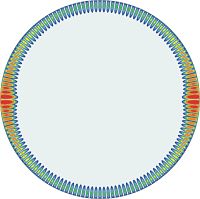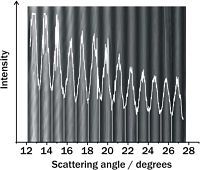Optical Techniques for Characterising Aerosol
Once a particle has been isolated in an optical trap or an electrodynamic balance, the size, composition and refractive index of the particle can be measured by elastic and inelastic light scattering. More specifically, the following techniques are used.
Cavity enhance Raman spectroscopy

CERS allows us to measure the composition, size and refractive index of a particle. From the spontaneous Raman signature, changes in chemical composition can be monitored from changing intensities in Raman scattered light intensity. At wavelengths that match whispering gallery modes, a spherical droplet acts as a low loss optical cavity, light can become trapped and the Raman scattered intensity amplified. From the unique fingerprint of resonant wavelengths that appear in the Raman band, the radius and refractive index of the droplet can be measured with an accuracy of better than +/- 0.025 %. Using the latest algorithms, the evolving size and refractive index can be determined in real time (1 s time resolution) as the droplet evolves. This approach is most often used to characterise optically tweezed droplets, benefiting from the high efficiency for collecting the Raman scattered light.
Phase function and elastic light scattering

The variation in the scattered light intensity with angle is referred to as the phase function. The phase function can be recorded using a CCD and used to determine the droplet size with high accuracy and to infer the size dependence of the refractive index. Using this approach, the evaporation of multi-component volatile droplets can be studied with sub-10 ms time-resolution and an accuracy of >+/- 25 nm in radius. This approach is most often used in combination with droplets trapped in an EDB or in a BB trap. Indeed, phase functions can be recorded at multiple scattering wavelengths and different polarisations simultaneously to improve the accuracy in the size determination.
Cavity ringdown spectroscopy

In CRDS, laser light is injected into an optical cavity and the decay time in light leaking from the cavity measured. When a scattering or absorbing aerosol is placed within the optical cavity, the time for the cavity to ringdown is reduced due to light extinction by the aerosol, allowing the determination of the extinction efficiency and refractive index.
